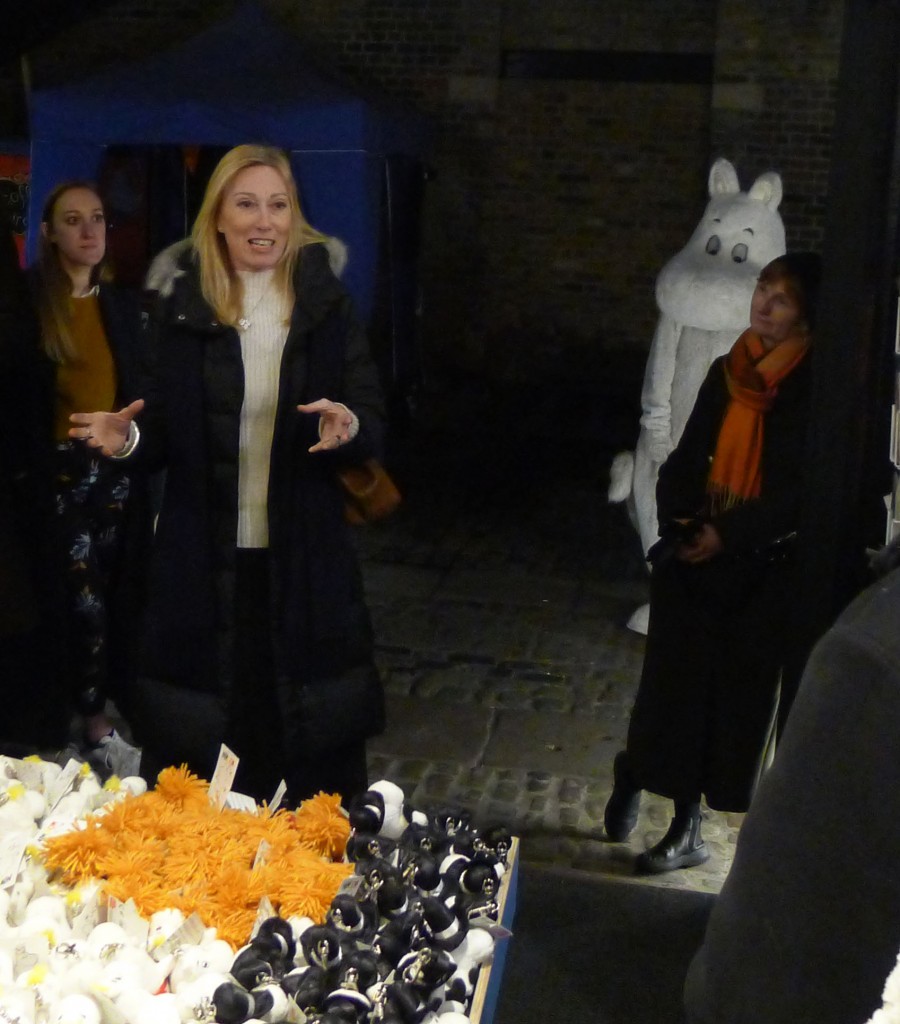An Evening With Sophia Jansson
London now boasts two Moomin shops; the original in Covent Garden, and a brand new store in Camden Market’s Stables. The latter had an important visitor this week – Tove Jansson’s niece Sophia, Creative Director of Moomin Characters. After being treated to a glass or two of wine, the audience were held rapt as Sophia related not only the creation and evolution of the Moomins, but some fascinating anecdotes about Tove herself.
“People often ask if she was working up until the day she died. And yes, she was,” said Sophia. In the final years of Tove Jansson’s life, her ability to draw had been impacted by a shaking hand. “People would come to her and say, “Please, draw me a Moomin!” But towards the end of her life, she wasn’t happy to do so – her line was so important to her and she wasn’t satisfied with what she drew.”
But Tove answered letters right up to the end. “She felt that if someone made an effort to reach out and connect, they deserved a reply. Of course, some people did so repeatedly and had to be discouraged.” We learned that Tove’s partner, Tuulikki Pietilä acted as a buffer – more often than not slamming down the phone with an emphatic “No!”
“But sometimes she was a bit too efficient! And Tove would whisper to someone else, “Could you please post this letter for me? Don’t tell Tuulikki!”” During her life, Tove Jansson personally responded to thousands of letters.
We also learned that Tuulikki’s brother Riema was a renowned architect who designed not only Mäntyniemi, the official residence of Finland’s president, but the elegant and organic library in Tampere. After completion, there was a vast basement space that wasn’t being used, and when it was suggested that they take the Moominhouse model built by Tove and Tuulikki, they jumped at the chance. “Tove thought, they can’t just have that on its own… so she donated hundreds of her illustrations, and it became the Moomin Museum.”
We also learned that Tove’s mother, Ham, had been to Britain in her youth, and fell in love with the Lake District. She learned to read in English and encouraged Tove and Lars to do the same from and early age. Stories of the South Seas and Tarzan had a particular impact on the young Janssons; both would make their mark in Moomin stories and also in Skatten på Tortuga, Lar Jansson’s first novel, published in 1941.
It was interesting to hear that after Tove wrote the first Moomin story – The Small Trolls and the Great Flood – it sat in a drawer for quite some time before she was prompted to publish it. When she did so, it was in booklet form, sold from kiosks in Helsinki. Only a few hundred of this first edition were ever printed. Comet in Moominland was a bigger deal, and when an acquaintance asked to translate Finn Family Moomintroll, the international success of the Moomins began in earnest.
In 1952, Charles Sutton from Associated Newspapers met Tove Jansson in Helsinki’s Kåmp hotel. It was April 30th, the eve of vappu, and a day of celebration in Finland. “I was not used to going out of my house during the day,” Tove Jansson once related in an interview, “So I didn’t think that day would be anything special. My god, the atmosphere at Kämp! Children, dogs, balloons… pretty girls climbed onto Sutton’s lap to play with his grey moustache.”
“Charles Sutton was so impressed,” said Sophia, “That he agreed a seven-year commission for a cartoon strip then and there. At least, that’s the version that we’ve always been told!”
As part of the deal, Tove went to London for lessons in creating cartoons. “Her first Moomin comic strip had the text flowing underneath. She had to learn to work in speech bubbles, to end on a cliffhanger. Each strip had to be a story all by itself. And her mother went with her too! She was delighted at the chance to see England again.”
We then heard the stories of the various Moomin television stories, beginning with the first Japanese serial. “There was only one TV channel in Japan at the time, so everyone watched the same thing. So anyone from that generation would have seen and remembered it.” The same applies to the 1970s Polish series, often called the ‘fuzzy felt’ Moomins, which was later adapted for British TV in 1983. And of course, there was the phenomenally successful Japanese anime of the 1990s, which sparked the ‘Moomin Boom’.
Before saying goodbye and leaving the audience to return not only to their wine but to a generous 20% discount for the evening, Sophia reminded us that there’s a new Moomin TV series in the works. “It’s coming in Spring 2019. And it’s going to be wonderful!”
